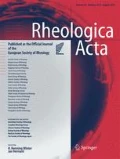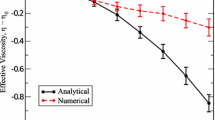Abstract
The linear viscoelasticity of a dilute suspension of active (self-propelled) rigid spheroidal particles is calculated under a small-amplitude oscillatory shear (SAOS) deformation. The imposed shear acts to drive the microstructure of the suspension, as parameterized by the orientational probability distribution function, out of equilibrium. The microstructure relaxes via two independent mechanisms: rotational Brownian motion and correlated tumbling; the combination of which results in an increased rate of stress relaxation, relative to a suspension that relaxes solely by either mechanism. We explicitly calculate the non-equilibrium orientational microstructure due to the SAOS deformation, rotational diffusion, and tumbling. From this, we determine the linear viscoelasticity of the suspension from the orientationally averaged stresslet, which arises from the imposed flow, rotational diffusion, and particle activity (self-propulsion). Next, we demonstrate that a modified Cox-Merz rule is applicable to a dilute, active suspension via a comparison of our linear viscoelasticity results to a theoretical prediction of the steady shear viscosity of active, slender rods (Saintillan, Exp Mech 50(9) 1275–1281, 2010). Finally, through a comparison of our results to experiments on Escherichia coli (López et al., Phys Rev Lett 115(2) 028, 301, 2015), we show that the linear viscoelasticity of an active suspension can be utilized to determine the mechanism of self-propulsion (i.e., pusher or puller), and estimate the strength of self-propulsion and correlation between tumbling events.






Similar content being viewed by others
References
Abdel-Khalik SI, Hassager O, Bird RB (1974) The Goddard expansion and the kinetic theory for solutions of rodlike macromolecules. J Chem Phys 61(10):4312–4316. doi:10.1063/1.1681736
Al-Hadithi TSR, Barnes HA, Walters K (1992) The relationship between the linear (oscillatory) and nonlinear (steady-state) flow properties of a series of polymer and colloidal systems. Colloid Polym Sci 270(1):40–46. doi:10.1007/BF00656927
Bechtel TM, Khair AS (2017) Nonlinear relaxation modulus via dual-frequency medium amplitude oscillatory shear (maos): general framework and case study for a dilute suspension of Brownian spheroids. J Rheology 61(1):67–82
Bird RB, Armstrong RC, Hassager O (1977) Dynamics of polymeric liquids. Volume 1: Fluid mechanics, edn. Wiley, New York
Bozorgi Y, Underhill PT (2014) Large-amplitude oscillatory shear rheology of dilute active suspensions. Rheologica Acta 53(12):899–909. doi:10.1007/s00397-014-0806-y
Brenner H, Condiff DW (1974) Transport mechanics in systems of orientable particles. IV. convective transport. J Colloid Interface Sci 47(1):199–264. doi:10.1016/0021-9797(74)90093-9
Chapman S, Cowling T (1991) The mathematical theory of non-uniform gases. Cambridge University Press, Cambridge
Chattopadhyay S, Moldovan R, Yeung C, Wu XL (2006) Swimming efficiency of bacterium Escherichia coli. Proc Natl Acad Sci 103(37):13,712–13,717. doi:10.1073/pnas.0602043103, arXiv:physics/0512219
Cox WP, Merz EH (1958) Correlation of dynamic and steady flow viscosities. J Polym Sci 28(118):619–622. doi:10.1002/pol.1958.1202811812
Dey KK, Wong F, Altemose A, Sen A (2016) Catalytic motors—quo vadimus?. Curr Opin Colloid Interface Sci 21:4–13. doi:10.1016/j.cocis.2015.12.001, http://linkinghub.elsevier.com/retrieve/pii/S1359029415001120
Dhar P, Cao Y, Kline T, Pal P, Swayne C, Fischer TM, Miller B, Mallouk TE, Sen A, Johansen TH (2007) Autonomously moving local nanoprobes in heterogeneous magnetic fields. J Phys Chem C 111(9):3607–3613. doi:10.1021/jp067304d
Ebbens SJ, Howse JR (2010) In pursuit of propulsion at the nanoscale. Soft Matter 6(4):726. doi:10.1039/b918598d
Gachelin J, Miño G, Berthet H, Lindner A, Rousselet A, Clément É (2013) Non-Newtonian viscosity of Escherichia coli Suspensions. Phys Rev Lett 110(26):268,103. doi:10.1103/PhysRevLett.110.268103
Haines BM, Aronson IS, Berlyand L, Karpeev DA (2008) Effective viscosity of dilute bacterial suspensions: a two-dimensional model. Phys Biol 5 (4):046,003. doi:10.1088/1478-3975/5/4/046003 10.1016/S0926-860X(98)00396-2, http://stacks.iop.org/1478-3975/5/i=4/a=046003?key=crossref.dd72c17be44d02d6e72f1d394e6cd465 http://stacks.iop.org/1478-3975/5/i=4/a=046003?key=crossref.dd72c17be44d02d6e72f1d394e6cd465
Hatwalne Y, Ramaswamy S, Rao M, Simha RA (2004) Rheology of active-particle suspensions. Phys Rev Lett 92(11):118,101. doi:10.1103/PhysRevLett.92.118101
Hinch EJ, Leal LG (1972) The effect of Brownian motion on the rheological properties of a suspension of non-spherical particles. J Fluid Mech 52(4):683–712
Hinch EJ, Leal LG (1976) Constitutive equations in suspension mechanics. Part 2. Approximate forms for a suspension of rigid particles affected by Brownian rotations. J Fluid Mech 76(01):187–208. doi:10.1017/S0022112076003200
Hong Y, Velegol D, Chaturvedi N, Sen A (2010) Biomimetic behavior of synthetic particles: from microscopic randomness to macroscopic control. Phys Chem Chem Phys 12(7):1423–1435. doi:10.1039/B917741H
Jeffery G (1922) The motion of ellipsodial particles immersed in a viscous fluid. Proc Roy Soc Lond A 102 (715):161–179
Kim S, Karrila SJ (2005) Microhydrodynamics: principles and selected applications. Dover Mineola, New York
Kline TR, Paxton WF, Mallouk TE, Sen A (2005) Catalytic nanomotors: remote-controlled autonomous movement of striped metallic nanorods. Angewandte Chemie 117(5):754–756. doi:10.1002/ange.200461890
Lauga E, Powers TR (2009) The hydrodynamics of swimming microorganisms. Rep Prog Phys 72 (9):096,601. doi:10.1088/0034-4885/72/9/096601, http://stacks.iop.org/0034-4885/72/i=9/a=096601?key=crossref.736a5c13368e75b7395f94099aead8e4
Leal LG, Hinch EJ (1971) The effect of weak Brownian rotations on particles in shear flow. J Fluid Mech 46(4):685–703. doi:10.1017/S0022112071000788
López HM, Gachelin J, Douarche C, Auradou H, Clément E (2015) Turning bacteria suspensions into superfluids. Phys Rev Lett 115(2):028,301. doi:10.1103/PhysRevLett.115.028301
Macosko CW (1994) Rheology: principles, measurements and applications. WIley-VCH, New York
McQuarrie DA (2000) Statistical mechanics. University Science Books
Mussler M, Rafaï S, Peyla P, Wagner C (2013) Effective viscosity of non-gravitactic Chlamydomonas Reinhardtii microswimmer suspensions. Europhys Lett 101(5):54,004. doi:10.1209/0295-5075/101/54004, arXiv:1310.1482
Patra D, Sengupta S, Duan W, Zhang H, Pavlick R, Sen A (2013) Intelligent, self-powered, drug delivery systems. Nanoscale 5(4):1273–1283. doi:10.1039/C2NR32600K
Rafaï S, Jibuti L, Peyla P (2010) Effective viscosity of microswimmer suspensions. Phys Rev Lett 104 (9):098,102. doi:10.1103/PhysRevLett.104.098102
Saintillan D (2010) The dilute rheology of swimming suspensions: a simple kinetic model. Exp Mech 50 (9):1275–1281. doi:10.1007/s11340-009-9267-0
Saintillan D, Shelley MJ (2008) Instabilities, pattern formation, and mixing in active suspensions. Phys Fluids 20(12):123,304. doi:10.1063/1.3041776
Schwarz-Linek J, Arlt J, Jepson A, Dawson A, Vissers T, Miroli D, Pilizota T, Martinez VA, Poon WC (2016) Escherichia coli as a model active colloid: a practical introduction. Colloids Surf B Biointerfaces 137:2–16. doi:10.1016/j.colsurfb.2015.07.048, http://linkinghub.elsevier.com/retrieve/pii/S0927776515300825
Sokolov A, Aranson IS (2009) Reduction of viscosity in suspension of swimming bacteria. Phys Rev Lett 103(14):148,101. doi:10.1103/PhysRevLett.103.148101
Spagnolie SE (2015) Complex fluids in biological systems. Biological and Medical Physics, Biomedical Engineering. Springer, New York. doi:10.1007/978-1-4939-2065-5
Stenhammar J, Marenduzzo D, Allen RJ, Cates ME (2014) Phase behaviour of active Brownian particles: the role of dimensionality. Soft Matter 10(10):1489–1499. doi:10.1039/C3SM52813H
Subramanian G, Koch DL (2009) Critical bacterial concentration for the onset of collective swimming. Journal of Fluid Mechanics 632:359. doi:10.1017/S002211200900706X
Sundararajan S, Lammert PE, Zudans AW, Crespi VH, Sen A (2008) Catalytic motors for transport of colloidal cargo. Nano Lett 8(5):1271–1276. doi:10.1021/nl072275j
Takatori SC, Yan W, Brady JF (2014) Swim pressure: stress generation in active matter. Phys Rev Lett 113(2):028,103. doi:10.1103/PhysRevLett.113.028103
Teo WZ, Pumera M (2016) Motion control of micro-/nanomotors. Chemistry—A European Journal pp 1–10. doi:10.1002/chem.201602241
Tjhung E, Cates ME, Marenduzzo D (2011) Nonequilibrium steady states in polar active fluids. Soft Matter 7(16):7453. doi:10.1039/c1sm05396e
Trueba FJ, Woldringh CL (1980) Changes in cell diameter during the division cycle of Escherichia coli. J Bacteriol 142(3):869–78. http://www.ncbi.nlm.nih.gov/pubmed/6769914, http://www.pubmedcentral.nih.gov/articlerender.fcgi?artid=PMC294112
Turner L, Ryu WS, Berg HC (2000) Real-time imaging of fluorescent flagellar filaments. J Bacteriol 182 (10):2793–2801. doi:10.1128/JB.182.10.2793-2801.2000
Wu M, Roberts JW, Kim S, Koch DL, DeLisa MP (2006) Collective bacterial dynamics revealed using a three-dimensional population-scale defocused particle tracking technique. Appl Environ Microbiol 72(7):4987–4994. doi:10.1128/AEM.00158-06
Acknowledgments
We thank Hriday Sattineni, a visiting undergraduate researcher from the Imperial College London, who verified our calculation for the uncorrelated tumbling regime (\(\beta = 0\)) and provided useful initial discussions. We acknowledge partial support from the Camille Dreyfus Teacher-Scholar Award program and the Department of Chemical Engineering at the Carnegie Mellon University.
Author information
Authors and Affiliations
Corresponding author
Ethics declarations
Note added in proof
After the present paper was accepted, a paper by S. Nambiar, P. R. Nott, and G. Subramanian (“Stress relaxation in a dilute bacterial suspension,” J. Fluid Mech. vol. 812, pp. 41-64) was published online on 22 December 2016. Their paper provides expressions for the storage (G′) and loss (G″) moduli of a suspension of slender bacteria under weak oscillatory shear (see below equation (3.1) in their work). Those expressions can be recovered from the complex viscosity reported in (23) and (24) of the present work by: (i) using the definitions G′ = ωη″ and G″ = ωη′; (ii) taking the limit of large aspect ratio, r → ∞; (iii) neglecting Brownian stress; and (iv) assuming a dipole strength σ 0 ∼ μ s μ s l 2, where μ s is the swimming speed of a bacterium.
Rights and permissions
About this article
Cite this article
Bechtel, T.M., Khair, A.S. Linear viscoelasticity of a dilute active suspension. Rheol Acta 56, 149–160 (2017). https://doi.org/10.1007/s00397-016-0991-y
Received:
Revised:
Accepted:
Published:
Issue Date:
DOI: https://doi.org/10.1007/s00397-016-0991-y




